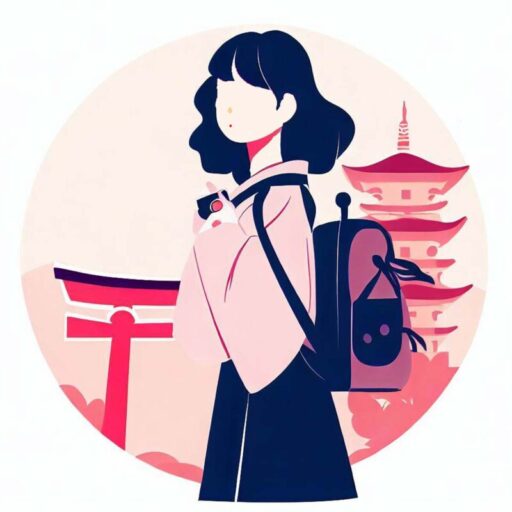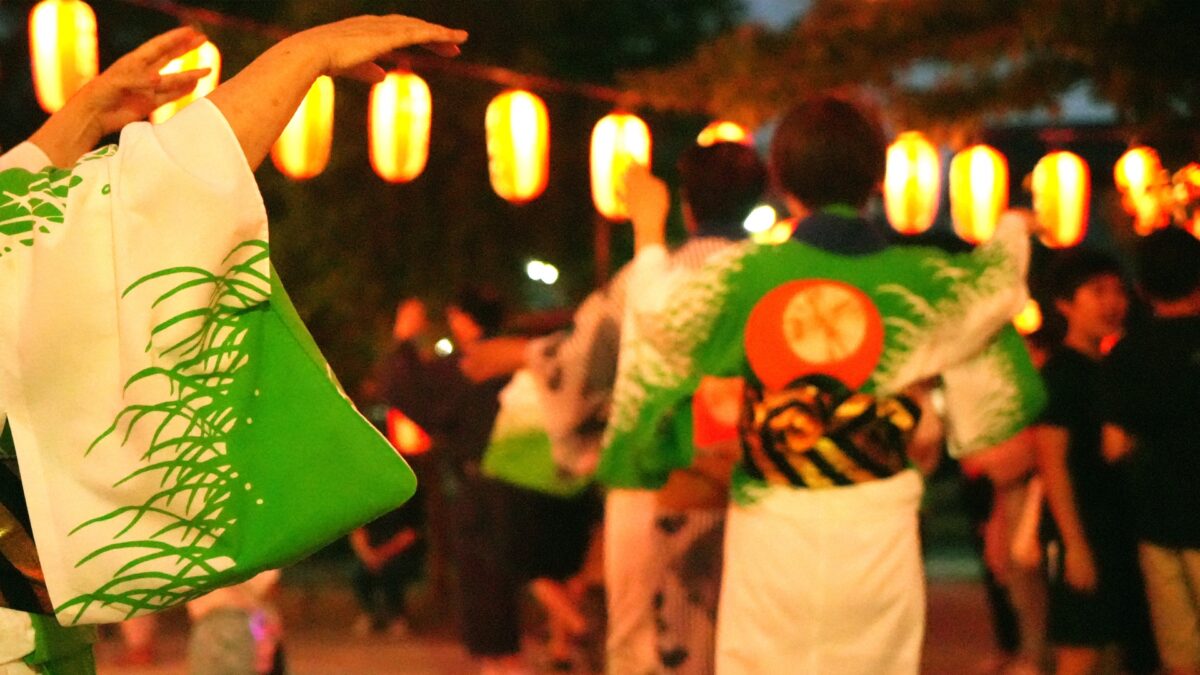The history of Obon and its inspiration to the present day – A journey through traditional events with a rich regional flavor and their origins

『 This article is… 』
Travel web writer Kasumi explains Japan’s Obon traditions and local customs. Introducing the charm of Obon in each region, from Okuribi in Kyoto to Awa Odori in Tokushima. Aimed at culture lovers and travel planners, this page provides an in-depth look at Japan’s summer traditions and the benefits of deepening your understanding of the local culture you should visit.
Hello everyone. My name is Kasumi and I am a travel web writer. I have traveled to every corner of this beautiful country in search of Japan’s seasonal scenery, but this time I would like to focus on a special period. It is “Obon”, a custom unique to Japan, and a heartwarming event where families gather to remember their ancestors. Having traveled to all 47 prefectures in Japan, I have come to realize how different Obon customs vary from region to region.
In this article, I will start by explaining the history and origin of Obon, then explain the characteristics of each region, and the way Obon is celebrated in modern times, along with my personal experiences. Please join us on a journey that introduces the charm of traditional events that have been passed down since ancient times, how they have been passed down to the present day, and how they are being reborn in new forms.
History and origin of Obon
Tracing the origins of Obon
Obon is an event that is said to have been introduced to Japan during the Muromachi period about 500 years ago. It was originally held as a memorial service to comfort the spirits of the deceased, based on the Buddhist Urabonkyo. However, in Japan there was a custom of worshiping ancestors even before that. What I was able to feel at the ancient shrines and temples I traveled to throughout Japan was that the customs of Obon are deeply rooted in the way of life of the ancient Japanese people. For this reason, Obon has developed in a unique way to suit Japan’s unique climate and culture.
Obon customs rooted in the region
For example, customs such as Kyoto’s Gozan Okuribi and Hokkaido’s spirit-nagashi strongly reflect the characteristics of each region. Daimonjiyaki is especially famous for Okuribi in Kyoto, and is known as an event to send the spirits of your ancestors. I myself witnessed this sacred scene once and was deeply impressed by its solemn atmosphere. In Hokkaido, spirits are sent away by floating lanterns in the sea or river. This is also a traditional event that is closely related to the local natural environment.
Changes in the Obon period
There are also regional differences in the timing of Obon. In many regions, it is celebrated around July 15th according to the lunar calendar, but today, as the solar calendar is adopted, many regions celebrate it from August 13th to 16th. However, there are exceptions, and in regions that follow the lunar calendar, Obon may be celebrated in September. These differences are also the result of differences in culture and lifestyle that each region has developed over its long history.
The modern meaning of Obon
Even in modern times, Obon is an important time for families to gather together. In addition to its original meaning of honoring ancestors, in modern times it also has the aspect of an annual family reunion. In fact, so many people return to their hometowns during the Obon period that it is called the U-turn rush. During this period, transportation such as expressways, Shinkansen trains, and airplanes are extremely congested, and transportation-related companies are offering special services to ease congestion during the Obon period. For example, JR companies may increase flights during the Obon period, and airlines such as ANA and JAL may offer discount campaigns on flight tickets in response to demand for returning home.
Obon is an important time to experience Japanese tradition, culture, and family bonds.
Obon customs and characteristics by region
Various aspects of Obon in the Japanese archipelago
Japan is a long archipelago with many cultures flourishing. Among these, Obon customs are one of the things that clearly expresses the characteristics of each region. Throughout my travels, I have had many experiences where I have been moved by Obon customs that reflect the colors of each region.
Obon in the Tohoku region
In the Tohoku region, Bon Odori'' is held in various places during Obon. In particular, Aomori Prefecture'sNebuta Festival” and Akita Prefecture’s “Kanto Festival” are known as major events that brighten up Obon. The sight of large floats paraded through the streets during the Nebuta Festival and lanterns hoisted high into the sky during the Kanto Festival amaze visitors. I still vividly remember feeling the excitement of these festivals and feeling the summer tradition.
Obon in the Kansai region
On the other hand, in the Kansai region, Obon customs are a little different. For example, the Okuribi of the five mountains mentioned earlier in Kyoto has the meaning of sending the spirits of those who have passed away. Additionally, in Osaka, there is a custom of spirit-nagashi, an event in which lanterns are floated into the sea to send away the spirits of ancestors. This custom has taken root precisely because the region has a deep connection with the sea.
Obon in Kyushu region
In Kyushu, Obon Odori'' is actively held during the Obon period. In particular, Nagasaki Prefecture'sSpirit Nagashi” is a grand event that attracts many tourists. This custom of floating lanterns aboard a boat out to sea has the meaning of sending the soul of the deceased to the afterlife. When I participated in this festival, the quiet beauty of the lanterns flowing with the solemn expressions of the people was deeply etched in my memory.
Okinawa’s Obon Festival “Bon Odori”
In Okinawa, Bon Odori,'' a dance performed to the rhythm of a traditional drum calledEisa,” is famous. Okinawa’s unique melancholy music and powerful dance set it apart from other Obon festivals. When I saw Eisa, I could feel the strong bond of Okinawan people who live together with their ancestors.
Japan’s rich culture reflected in local customs
These Obon customs in each region are unique cultures that have been nurtured by the climate, history, and lifestyle of the people in each region. Through these various events, I was able to experience Japan’s rich cultural heritage firsthand.
Changes in Obon and its meaning in modern times
Fusion of tradition and modernity
In modern Japanese society, Obon customs are being passed down in new forms while still preserving tradition. As technology advances and lifestyles change, the way we celebrate Obon has changed, but in the hearts of Japanese people, we still maintain the basic values of respecting our ancestors and valuing our families. It is firmly rooted.
Changes brought about by digitalization
Recently, it is not uncommon for families who live far away to meet online for “online obon.” For example, you can use video calling features such as Zoom or Skype to communicate with family members far away and share the Obon season. I personally had a new experience of spending Obon together while connecting with my family online while traveling.
Changes in travel trends during the Obon period
There are also noteworthy changes in domestic travel trends during the Obon period. Looking at recent data, the number of people using Obon to travel domestically and internationally is increasing. According to a survey by the Japan Tourism Agency, the number of domestic travelers during the Obon period is increasing year by year, making it one of the most important periods for the travel industry. On the other hand, data from the Statistics Bureau of the Ministry of Internal Affairs and Communications shows that the percentage of people returning home is decreasing, and this is having an impact on the travel industry.
Commercialization of Obon and its impact
The Obon season is one of the major commercial events. Supermarkets and department stores have set up “Obon Markets,” where Obon decorations and offerings are sold, making it a huge sales battle. In addition, various service industries are playing a role in revitalizing consumption, such as by running Obon-only campaigns.
The spirit of Obon and modern society
Amid such changes, how is the original spirit of Obon preserved? Even with the speed of modern society, Obon is a time for Japanese people to “stop, reflect, and be grateful.” It has not lost its value as an opportunity to express gratitude to our ancestors and reaffirm our ties to family and community.
The traditional values of Obon remain firmly at their core while adapting flexibly to changes in modern society.
Impact of changes in Obon on our lives
Rebuilding family ties and community
The Obon period is a valuable time for many Japanese people to confirm and rebuild ties with family and relatives. In regional cities and rural towns, families returning from urban areas can be seen enjoying reunions once a year. This homecoming facilitates communication between family members and contributes to strengthening kinship relationships that are often estranged. In the small villages I visited, during the Obon period, the usual quietness changed completely and some became lively.
Impact on local economy
The Obon season has a big impact on the local economy. For example, modes of transportation that are crowded with people returning home, especially trains and buses, reach their peak during the Obon period. JR companies and local transportation companies will take measures such as operating special trains to increase transportation capacity during the Obon period. Additionally, sales during this period often contribute significantly to annual profits for local tourism and retail industries.
Impact on traditional industries
Obon is also an important business opportunity for traditional industries related to Obon, such as manufacturers of incense sticks, candles, and Buddhist flowers. Especially in Japan’s handmade Buddhist utensils market, Obon is a time that greatly influences sales for the year, and craftsmen also prepare for this period.
Transformation of social and cultural consciousness
The evolution of Obon has also affected social and cultural consciousness. As traditional values and modern lifestyles intersect, many people have come to value spiritual fulfillment and time with family. As I travel around the country, I feel that the way people view Obon is diversifying, regardless of age or gender.
Obon and Japanese identity
During Obon, the identity of the Japanese people also draws attention. The traditional values of ancestor worship are respected even in today’s busy lives, and are an opportunity for Japanese people to reaffirm their roots and identity. For Japanese people living overseas, Obon is also an opportunity to think about Japan and reflect on our cultural roots.
The influence Obon has on modern society goes beyond just an annual event and extends to the lifestyle, economic activities, and even cultural identity of the Japanese people. In the next part, I would like to think about how the tradition of Obon will change in the future and how it may affect our future.
The future of Obon: the evolution of tradition and its possibilities
Searching for a new tray shape
In modern Japan, Obon is changing its form. As urbanization and nuclear families progress, an increasing number of families are finding it difficult to return home and carry on traditional events. In response to this, new forms of Obon are being explored, such as Obon events sponsored by local communities and simplified Obon rituals.
Growing environmental awareness and Obon
Obon events are also changing as people become more concerned about the environment. There are movements being conscious of sustainability, such as efforts to avoid wasting offerings and choosing eco-friendly obon supplies. One town I visited was trying to conserve the environment and revitalize the local economy by growing flowers and offerings for Obon locally.
Fusion of technology and Obon
Advances in technology are contributing to the creation of new Obon customs. For example, a new type of Obon festival is becoming possible, where families living in remote areas come together through virtual reality (VR). This allows families to transcend physical distance and share experiences that bring them together.
The cultural power of Obon
Obon also has the power to communicate culturally both domestically and internationally. The number of tourist events themed around Obon as a traditional Japanese culture and the use of Obon as a venue for international exchange are increasing. I have had the experience of explaining the meaning of Obon to foreign tourists, and I realized that they are deeply interested in Japanese culture.
Continuation of tradition and innovation
The key to the future of Obon is the balance between tradition and innovation. In order to pass on the tradition of Obon to the future, it is important to convey the significance of Obon to the younger generation and for them to evolve its form to suit their own lifestyles. While we respect tradition, we should also have the flexibility to incorporate new values.
The future of Obon lies at the intersection of past, present, and future. Obon, which continues to change with the times while preserving tradition, can be said to symbolize the dynamism of Japanese society and culture.
Summary and thoughts
The Obon season is a precious moment in which we not only look back on the past, but also face ourselves and build a bridge to the future. Through this series, we have explored the history and origins of Obon, regional customs, its role in modern society, and its evolution into the future. During my travels throughout Japan’s 47 prefectures, I have witnessed how Obon is cherished in many parts of Japan, and each region has its own unique culture.
Obon is one of Japan’s beautiful customs, where families gather, honor ancestors, and bring communities together. However, the appearance of Obon, which continues to change with the passage of time, constantly asks us how we should strike a balance between tradition and innovation.
Every time I celebrate Obon, I feel closer to Japan’s history and have the opportunity to remember my roots. And it is deeply connected to the countless stories I have sensed while traveling in Japan. Even in today’s busy lives, we believe that the tranquility and warmth of gathering that Obon brings are essential elements for our hearts.
I would be happy if I could provide various perspectives on Obon through this blog. The rich history and evolution of Obon is deeply rooted in our Japanese identity, and it is the role and joy of each of us to pass it on to the future. I hope that Obon will continue to be more than just a holiday, but a cultural cornerstone that enriches the soul and connects people.
Kasumi point
Kyoto Prefecture: Spirit Nagashi and Gosan Okuribi
Kasumi points:
Obon in Kyoto is especially known for the spirit-nagashi and Gozan Okuribi festivals. Spirit Nagashi is an event that sends away the spirits of ancestors by floating lanterns down the river, and is famous for the Kamo River in Kyoto. Additionally, the Gozan Okuribi ceremony, held on the night of August 16th, is a grand event in which the mountains, including Daimonji, are lit on fire to send out the spirits of the ancestors. This gives a sense of the Obon atmosphere that is unique to Kyoto, and many tourists gather to see this spectacle.
Gifu Prefecture: Gujo Odori
Kasumi points:
In the Gujo region of Gifu Prefecture, Gujo Odori is held during the Obon period. This is considered one of the three major Bon dances in Japan, and the sight of them dancing all night long is a sight to behold. Dance plays an important role in strengthening local communities and deepening bonds between generations. Gujo Odori is loved by many people as a living culture that conveys the traditions of the region.
Kagoshima Prefecture: Shoroma, the spirit horse of Obon
Kasumi points:
In Kagoshima Prefecture, there is a custom of making “Seiuma” during Obon. This is an offering made of bamboo or rice straw in the shape of a horse or cow, and is said to be a vehicle for the spirits of the ancestors to ride home. The spirit horses displayed at the entrances of homes symbolize the bond with ancestors and play an important role in praying for the safety and health of the family.
Tokyo: Asakusa Samba Carnival
Kasumi points:
When you think of Obon, you may imagine a quiet family gathering, but in Asakusa, Tokyo, you can experience a unique Obon festival. Asakusa Samba Carnival is often held during the Obon period, and is a colorful festival reminiscent of Brazil’s Rio Carnival. Unlike traditional Japanese Obon, this international event offers a new way to enjoy Obon.
Tokushima Prefecture: Awa Odori
Kasumi points:
In Tokushima Prefecture, Awa Odori'' is held during Obon. This is famous as a traditional Japanese Bon dance, and many dancers perform dynamic dances while chantingYoshiko” and “Hagi.” Awa Odori also contributes to the formation of local communities, and is so popular that it attracts tourists from all over the world. This festival preserves the traditions of Obon while also playing a role in revitalizing the region.
During the Obon period, various traditional events are held all over Japan, and the characteristics of each region are strongly expressed. These events not only preserve old customs, but also play an important role in passing on culture to new generations and deepening local bonds. By communicating the unique charms of each Obon event as “Kasumi Points,” we hope that more people will be able to learn about its wonderfulness. It is a tradition that we will continue to cherish as part of Japan’s rich cultural heritage.




